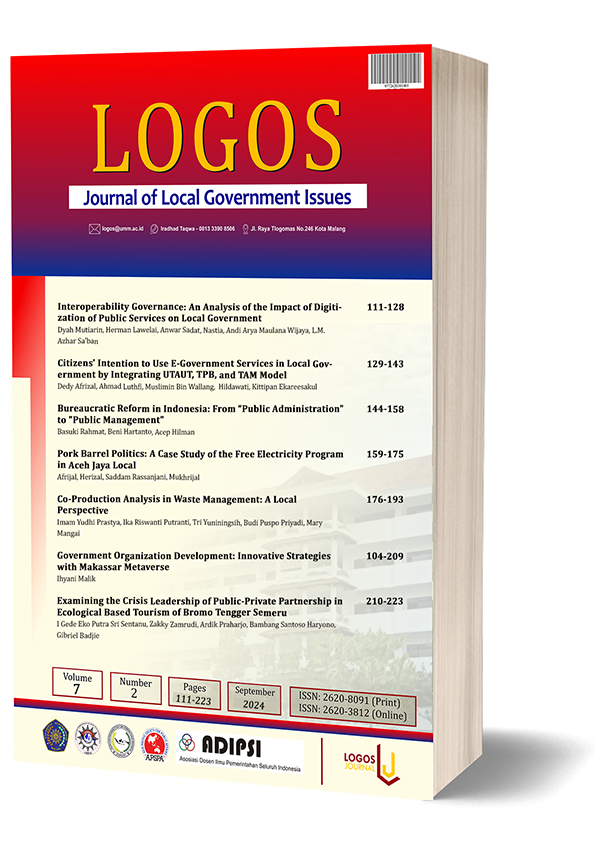Citizens' Intention to Use E-Government Services in Local Government by Integrating UTAUT, TPB, and TAM Model
DOI:
https://doi.org/10.22219/logos.v7i2.32437Keywords:
E-Government, Intention to use, Local Government, Public Service, UTAUT ModelAbstract
In contemporary society, the widespread adoption of information and communication technologies has become integral to meeting daily needs. E-Government leverages these technologies to deliver efficient and secure services to citizens, particularly at the local government level. However, existing literature lacks comprehensive exploration into citizen preferences for utilizing e-government services, especially those offered by local governments. Addressing this gap, this study investigates citizen intentions to use e-government, focusing on the application system provided by local governments. Our research framework integrates three established models (UTAUT, TAM, and TPB) and employs empirical validation through a structured questionnaire. Data collection involved 97 respondents from diverse cities/regencies. Rigorous reliability and validity assessments were conducted on the questionnaire, with analysis performed using structural equation modeling (SEM). The findings underscore the significant influence of citizens' attitudes toward e-government, shaped by factors such as effort expectancy, facilitating conditions, and perceived risk. Furthermore, a positive and significant relationship between attitude and Intention to use revealed. This research contributes to a deeper understanding of citizen behavior towards e-government services, offering insights crucial for enhancing service delivery and citizen engagement at the local level.
Downloads
References
Afrizal, D., Saputra, R. I., & Ilyanzah, D. (2023). YUME : Journal of Management E-Government Usage : Taxpayers ’ Determining Factors in Using The E-Filing Application in Dumai City. YUME : Journal of Management, 6(3), 120–135. https://doi.org/https://doi.org/10.37531/yum.v6i2.6101
Afrizal, D., Wallang, M. Bin, Hijeriah, E. M., Erlianti, D., & Yusuf, I. M. (2023a). E-Government services : Improving employment services in Dumai City. PUBLISIA: Jurnal Ilmu Administrasi Publik, 8(2), 148–159. https://doi.org/10.26905/pjiap.v8i2.10266
Afrizal, D., & Wallang, M. (2021). Attitude on intention to use e-government in Indonesia. Indonesian Journal of Electrical Engineering and Computer Science, 22(1), 435–441. https://doi.org/10.11591/ijeecs.v22.i1.pp435-441
Afrizal, D., Wallang, M., Hijeriah, E. M., Erlianti, D., & Yusuf, I. M. (2023b). E-Government services: Improving employment services in Dumai City. Publisia: Jurnal Ilmu Administrasi Publik, 8(2), 148–159. https://doi.org/10.26905/pjiap.v8i2.10266
Agostino, D., Saliterer, I., & Steccolini, I. (2022). Digitalization, accounting and accountability: A literature review and reflections on future research in public services. Financial Accountability and Management, 38(2), 152–176. https://doi.org/10.1111/faam.12301
Ajzen, I. (1991). “The Theory of Planned Behavior,” Organizational Behavior and Human Decision Processes. 50(2), 179.
Alhadid, I., Abu-taieh, E., Alkhawaldeh, R. S., & Khwaldeh, S. (2022). Predictors for E-Government Adoption of SANAD App Services. International Journal of Environtmental Research and Public Health, 19, 1–26. https://doi.org/10.3390/ijerph19148281
Anshari, M., & Hamdan, M. (2023). Enhancing e-government with a digital twin for innovation management. Journal of Science and Technology Policy Management, 14(6), 1055–1065. https://doi.org/10.1108/JSTPM-11-2021-0176
Biruk, K., & Abetu, E. (2019). Informatics in Medicine Unlocked Modeling predictors of acceptance and use of electronic medical record system in a resource limited setting : Using modi fi ed UTAUT model. Informatics in Medicine Unlocked, April, 100182. https://doi.org/10.1016/j.imu.2019.100182
Carter, L., Yoon, V., & Liu, D. (2022). Analyzing e-government design science artifacts: A systematic literature review. International Journal of Information Management, 62(October 2021), 102430. https://doi.org/10.1016/j.ijinfomgt.2021.102430
Das, A., & Das, S. S. (2021). E-Government and Entrepreneurship: Online Government Services and the Ease of Starting Business. Information Systems Frontiers, 1027–1039. https://doi.org/10.1007/s10796-021-10121-z
Davis FD, B. R. and W. P. (1989). User acceptance of computer technology A comparison of two theoretical models. Management Science, 35(8), 982–1003.
Dwivedi, Y. K., Rana, N. P., Janssen, M., Lal, B., Williams, M. D., & Clement, M. (2017). An empirical validation of a uni fi ed model of electronic government adoption ( UMEGA ). Government Information Quarterly, 34(2), 211–230. https://doi.org/10.1016/j.giq.2017.03.001
Hair Jr, J. F., Hult, G. T. M., Ringle, C., & Sarstedt, M. (2014). A primer on partial least squares structural equation modeling (PLS-SEM). Sage publications.
Hung, S., Chang, C., & Kuo, S. (2013). User acceptance of mobile e-government services : An empirical study. Government Information Quarterly, 30(1), 33–44. https://doi.org/10.1016/j.giq.2012.07.008
Karman, K., Deswanto, R., & Ningsih, S. A. (2021). Implementasi E-Government Pada Pemerintah Daerah. Jurnal Studi Ilmu Pemerintahan, 2(2), 43–50. https://doi.org/10.35326/jsip.v2i2.1525
Khamis, R. (2023). Measuring Citizens’ Acceptance and Usage of E-Government Services: Applying the Technology Acceptance Model (TAM) in Egypt. The American University in Cairo.
Lai, P. C. (2017). The literature review of technology adoption models and theories for the novelty technology. JISTEM-Journal of Information Systems and Technology Management, 14(1), 21–38.
Mwilongo, K., & Kachota, B. (2023). A Systematic Review on the Extant of Tanzania e- Government Services for Economic Development. Research Square, 1–12.
Nurkholis, N., & Anggraini, R. Y. (2020). Determinants of E-Government Implementation Based on Technology Acceptance Model. Jurnal Dinamika Manajemen, 11(2), 184–197. https://doi.org/10.15294/jdm.v11i2.23853
Rana, N. P., Dwivedi, Y. K., Lal, B., Williams, M. D., & Clement, M. (2017). Citizens ’ adoption of an electronic government system : towards a unified view. Information Systems Frontiers, 19(3), 549–568. https://doi.org/10.1007/s10796-015-9613-y
Schaupp, L. C., & Carter, L. (2005). E-voting: From apathy to adoption. Journal of Enterprise Information Management, 18(5), 586–601. https://doi.org/10.1108/17410390510624025
Setiawan, Z., Hildawati, H., Sanulita, H., Afrizal, D., Ibrahim, S. M., Susanto, A., Indahyani, T., Adiwijaya, S., Laka, L., Ansor, M., Andari, S., Putra, M. F. M., Martawijaya, A. P., & Judijanto, L. (2024). Methodologi Dan Teknik Penulisan Ilmiah. PT. Sonpedia Publishing Indonesia.
Tejedo-Romero, F., Araujo, J. F. F. E., Tejada, Á., & Ramírez, Y. (2022). E-government mechanisms to enhance the participation of citizens and society: Exploratory analysis through the dimension of municipalities. Technology in Society, 70(March). https://doi.org/10.1016/j.techsoc.2022.101978
Trischler, J., & Westman Trischler, J. (2022). Design for experience–a public service design approach in the age of digitalization. Public Management Review, 24(8), 1251–1270. https://doi.org/10.1080/14719037.2021.1899272
United Nations. (2023). E-Government-Development Index. United Nation.
Veeramootoo, N., Nunkoo, R., & Dwivedi, Y. K. (2018). What determines success of an e-government service? Validation of an integrative model of e-filing continuance usage. Government Information Quarterly, 35(2), 161–174. https://doi.org/10.1016/j.giq.2018.03.004
Venkatesh, V. (2021). Adoption and use of AI tools: a research agenda grounded in UTAUT. Annals of Operations Research, (308), 641-652. https://doi.org/10.1007/s10479-020-03918-9
Venkatesh, V., Morris, M. G., Davis, G. B., & Davis, F. D. (2003). User Acceptance of Information Technology: Toward A Unified View. MIS Quarterly, 27(3), 425–478.
Venkatesh, V., Morris, M. G., Davis, G. B., & Davis, F. D. (2012). User Acceptance Of Information Technology: Toward A Unified View. MIS Quarterly, 27(3), 425–478.
Verkijika, S. F., & Wet, L. De. (2018). E-government adoption in sub-Saharan Africa. Electronic Commerce Research and Applications, 30(May), 83–93. https://doi.org/10.1016/j.elerap.2018.05.012
Wallang, M. (2018). Determinants that Influence Citizen’s Usage of Different E-Government Services: A Malaysian Case Study. The University of Queensland.
Williams, M. D., Rana, N. P., & Dwivedi, Y. K. (2015). The unified theory of acceptance and use of technology (UTAUT): A literature review. Journal of Enterprise Information Management, 28(3), 443–448. https://doi.org/10.1108/JEIM-09-2014-0088
Xie, Q., Song, W., Peng, X., & Shabbir, M. (2017a). Predictors for e-government adoption: Integrating TAM, TPB, trust and perceived risk. The Electronic Library, 35(1), 2–20. https://doi.org/10.1108/EL-08-2015-0141
Xie, Q., Song, W., Peng, X., & Shabbir, M. (2017b). Predictors for e-government adoption: Integrating TAM, TPB, trust and perceived risk. Electronic Library, 35(1), 2–20. https://doi.org/10.1108/EL-08-2015-0141
Zhao, F., & Khan, M. S. (2013). An empirical study of e-government service adoption: culture and behavioral intention. Int. J. Public Admin, 36(10), 710–722. https://doi.org/10.1080/01900692.2013.791314
Zolotov, M. N., Oliveira, T., & Casteleyn, S. (2018). E-participation adoption models research in the last 17 years: A weight and meta-analytical review. Computers in Human Behavior, 81, 350–365.
Zubir, M. H. H., & Latip, M. S. A. (2022). Behavioural Intention to use E-government Services in Malaysia: Extended TAM Model to Examine the Effect of Perceived Security. Journal of Administrative Science, 19(2), 119–139. Retrieved from https://journal.uitm.edu.my/ojs/index.php/JAS/article/view/2559
Downloads
Published
How to Cite
Issue
Section
License
Copyright (c) 2024 Dedy Afrizal, Ahmad Luthfi, Muslimin Bin Wallang, Hildawati Hildawati, Kittipan Ekareesakul

This work is licensed under a Creative Commons Attribution-ShareAlike 4.0 International License.
Authors who publish with this journal agree to the following terms:
- Authors retain copyright and grant the journal right of first publication with the work simultaneously licensed under a Creative Commons Attribution-ShareAlike 4.0 International License. that allows others to share the work with an acknowledgment of the work's authorship and initial publication in this journal.
- Authors are able to enter into separate, additional contractual arrangements for the non-exclusive distribution of the journal's published version of the work (e.g., post it to an institutional repository or publish it in a book), with an acknowledgment of its initial publication in this journal.
- Authors are permitted and encouraged to post their work online (e.g., in institutional repositories or on their website) prior to and during the submission process, as it can lead to productive exchanges, as well as earlier and greater citation of published work (See The Effect of Open Access).

This work is licensed under a Creative Commons Attribution-ShareAlike 4.0 International License.













